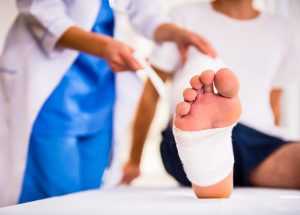North Carolina Foot Injury Attorney
 Traumatic foot injuries can be terribly painful and profoundly disabling. Because all body weight is supported by the feet with every step, foot injuries are slow to heal unless the patient avoids weight bearing entirely. Foot pain can also cause a tremendous amount of minute-by-minute discomfort for the victim.
Traumatic foot injuries can be terribly painful and profoundly disabling. Because all body weight is supported by the feet with every step, foot injuries are slow to heal unless the patient avoids weight bearing entirely. Foot pain can also cause a tremendous amount of minute-by-minute discomfort for the victim.
Certain foot conditions occur by repetitive use and commonly appear without trauma. One example is plantar fasciitis. This condition causes a tremendous amount of pain when walking. While trauma can cause or increase symptoms of plantar fasciitis, the condition is typically degenerative. Podiatrists confirm that pain associated with this condition can prevent almost all physical function for a patient. Contact foot injury attorney today.
The foot is made up of twenty-six bones and more than one hundred muscles, joints, and ligaments that work together to facilitate balance and movement. Because the feet bear all body weight, they are subject to enormous pressure and punishment. During an average day, a person spends about four hours standing and takes up to ten thousand steps. Also, each foot independently bears the full weight of the body and a person’s body weight is distributed over just five points when the foot is on the ground. These contact points include the heel and the four end points of the other long bones of the foot.
Improper shoes are a primary cause of foot pain. However, trauma is also a common source of foot problems. Twenty percent of all drivers in car accidents sustain at least one lower-extremity fracture with the foot and ankle sustaining the highest rate of breaks. Statistics show that foot and ankle trauma accounts for 8 to 12 percent of all moderate to severe injuries sustained in frontal collisions. Patients who suffer foot fractures show no improvement six to twelve months after the initial injury, and only 58 percent return to work on a full-time basis after one year.
Anatomically, there are two surfaces of the foot, the dorsal (or top) section and the plantar (or bottom) section of the foot. Doctors identify three major sections of the foot: the forefoot, the midfoot, and the hind foot. Although many bones provide the foundation and flexibility of the foot, the arches of the foot support the weight of the human body. The foot has three arches formed by the metatarsal bones. The highest and most important arch is the medial arch. This is the familiar arch located on the inside middle portion of the foot. Height and elasticity of the arch help to absorb shock and support body weight and balance. The lateral arch is on the outside of the foot and has only slight elevation. This arch is maintained by two strong ligaments. The third arch is the transverse arch, which stretches across the width of the foot. Severe foot fractures can result in a collapse of the bones that form a spring-like frame and guide overall foot function. These injuries are always permanent. Invasive surgery may require installation of screws, plates, and other hardware. Because of the typical extent of use and flexion of the foot, hardware can easily become loosened, which would require later repair or removal. Nerve damage is also quite common and can produce extensive, chronic pain.
Foot drop is another complication arising from foot injury. This is a neuromuscular disorder that affects the victim’s ability to raise or move the foot at the ankle inward or outward. The condition is often only a symptom of a larger problem, such as a back problem involving the peroneal nerve deep within the low back. This condition can arise from sciatic nerve trauma, a fractured leg or vertebra, a crush injury, or medical conditions, such as stroke, tumor, or diabetes. Development of foot drop is also a common result of total knee replacement. Considering the various causes of foot drop, detailed medical evidence must show the connection between foot drop and collision trauma.
Foot fractures constitute 10 percent of all broken-bone cases. The foot contains one-quarter of the bones in the body. The soft tissue and ligament structure is extremely complex and highly susceptible to traumatic injury. In all foot-injury cases, care should be taken to consider the obvious and primary diagnosed injuries and any potential complications that may arise over the balance of the victim’s lifetime. Insurance adjusters will not offer a proper settlement unless detailed medical evidence confirms the true extent of the foot injury and all past and future symptoms.
Careful attention should be invested in the preparation and presentation of all foot-injury cases. Insurance companies always try to argue that foot pain is secondary to age or degeneration. Because physicians have difficulty unraveling the origin of foot pain, they may be reluctant to offer a clear medical opinion relating the foot pain to the motor vehicle collision. Careful research and analysis should overcome these complications. Ultimately, the plaintiff’s burden of proof at trial is by preponderance of the evidence. Thus, you need only show that the foot pain and condition were, more likely than not, caused by the vehicle collision. When seeking this medical evidence, the physician’s attention should be focused on all pre-accident and post-accident difficulties and all diagnostic imaging and test results before answering whether the claimed foot injury was a result of the accident. Proper medical evidence motivates large settlements and verdicts in foot-injury cases. Contact foot injury attorney today.
